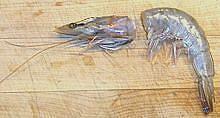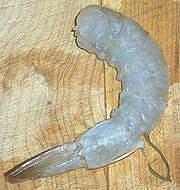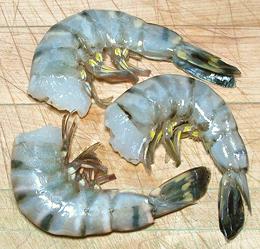
SAFARI
Users
Buying & Storing Shrimp
Are You Getting What You're Paying For? Actual Genetic testing by Oceana has shown that at least 30% of shrimp sold in the United States are mislabeled - from 43% in New York City, to 33% in Washington DC and down to 5% in Portland, Oregon. Most commonly, "Wild Caught" is used to describe farmed shrimp. It is pretty much impossible to tell what you're getting unless it's at least "shell-on" and preferably "head-on", but if the sign says "White Shrimp, farm raised", that's almost certainly what they are, though point of origin may still be misrepresented.
Restaurants, notorious for deception in fish, are less so for shrimp, because all they tell you is "shrimp". If they claim more, don't expect them to be more trustworthy than anyone else.
There are hundreds of varieties of shrimp, but mainly we buy by size and price from whatever's available in our local stores. Varieties farmed depend on where they are farmed and may change over time for better yield or virus resistance.
Fortunately, this lack of choice isn't nearly as serious it would be with fish, because most shrimp are very similar in taste and texture, though there are exceptions. If a recipe calls for "fresh water" Shrimp or Prawns you might want to get those if you can. Freshwater are usually found in frozen packages because they are more perishable than salt water varieties. Asian markets have the best selection of all kinds of shrimp and prawns in various stages of preparation, from live and swimming to cooked and ready to eat.
The main points are to buy shrimp as fresh as possible (they should have almost no odor) from a reputable source with high turn-over, and in the best form for your application. Then keep them well chilled until used. If they won't be used within a day or so, freeze them or buy them already frozen. Use frozen shrimp within a month or two (they tend to dry out).
If you buy shrimp with the head on, needed for many European and ethnic recipes (or if you just want to make a really good shrimp broth), cook them within a few hours, or keep them frozen. Digestive enzymes in the head tend to make the meat mushy. In the case of Ridgeback shrimp, this digestion process is very fast.
Forms commonly sold are:
Head-On:
Fresh or previously frozen. Yield: 1 pound = 10 oz of tail meat (white shrimp, 63%). These generally cost about a dollar less per pound than head-off but yield less meat. You buy these for recipes that ask for head-on or generally to make a richer shrimp stock (particularly for some sauces) than the shells alone would yield. Head-on shrimp should be used as soon as possible after thawing - the head contains enzymes that will start digesting the shrimp. Sushi bars serve "sweet shrimp" - the tails served raw on sushi rice and the heads sent to the kitchen to be deep fried. When the head is returned to you, you eat it all (unless you are a wimp).Head-off, Shell-on:
Fresh, frozen or previously frozen. Yield: 1 pound = 15 oz of tail meat (white shrimp, tail fin left on 94%). There's not much to the shells, but they'll still yield a nice light broth which I often mix into fish stock. Some recipes call for the shells to be fried crisp in a little oil before simmering, but I didn't like them that way."Easy Peel":
These are headless with most of the shell still on, but a "V" cut down the back removing the vein and the meat and shell above it. The specimens I have purchased were almost devoid of shrimp flavor.Head-Off peeled and "de-veined":
Ready to cook with no further preparation needed. Clearly these are going to be more expensive than "shell-on" because there's more handling. You don't get shells for broth either, and flavor probably suffers as well.Head-Off peeled, de-veined and cooked:
You get no broth, no cooking control, they're usually already severely overcooked, and flavor is usually very weak. OK for mixing into banquet salads, I guess.Sizes:
Shrimp are packaged by number to a pound weight. Unfortunately, sizes aren't standardized, so there is some variation from this chart, but these are the most common.Size count / # 3 oz serving Tiny 71+ 18+ Extra Small 61 - 70 15 - 17 Small 51 - 60 12 - 15 Medium 41 - 50 10 - 12 Medium Large 36 - 40 9 - 10 Large 31 - 35 8 - 9 Extra Large 26 - 30 6 - 7 Jumbo 21 - 25 5 - 6 Extra Jumbo 16 - 20 4 - 5 Colossal 13 - 15 3 - 4 Super Colossal U-12 (< 12) 2 - 3 Extra Colossal U-10 (< 10) 2 - 3
Preparing "Shell-on" Shrimp
 The main tool and requirement for preparing shrimp is a good thumbnail on
your primary hand. Keep the shrimp fully chilled until ready to peel and
toss the tail meat into a pan of ice water immediately after shelling.
The main tool and requirement for preparing shrimp is a good thumbnail on
your primary hand. Keep the shrimp fully chilled until ready to peel and
toss the tail meat into a pan of ice water immediately after shelling.
Pull off the head. There is no meat in the main body, only in the tail section. Toss the head in a pot for broth.
Break the shell from the bottom, the weakest place. If you're
keeping the tail on, hold the shrimp firmly by the last segment and pull
away the next shell segment forward first. Then do the rest in any order.
 De-vein if needed. In many parts of the world this just wouldn't
be done at all, but Americans can be finicky about these things. The
"vein" is the digestive tract which runs down the back of the tail.
Some farmed shrimp are kept without food long enough to empty out, so if
you can't see the vein you don't need to remove it. There's another dark
thread on the bottom side which is not digestive and is never removed.
De-vein if needed. In many parts of the world this just wouldn't
be done at all, but Americans can be finicky about these things. The
"vein" is the digestive tract which runs down the back of the tail.
Some farmed shrimp are kept without food long enough to empty out, so if
you can't see the vein you don't need to remove it. There's another dark
thread on the bottom side which is not digestive and is never removed.
Commercial operations cut a "V" notch down the back of the shrimp but this means lost meat and a shrimp that spreads out when cooked. Just take a thin bamboo skewer and run it between the last two segments deep enough to get under the gut. Pull gently up and back towards the tail, rolling the skewer between your fingers in the direction that would tend to wind the gut towards the tail. If the gut breaks, you can probably find it up at the front and pull it out forward, or just try again with the skewer between the next segments. Don't worry about that last segment, the gut dives through it to the underside and there's no practical way to remove that bit.
 This technique can actually be used to de-vein shrimp still in the shell,
which is called for in some recipes where the shrimp is served with the
shell still on.
This technique can actually be used to de-vein shrimp still in the shell,
which is called for in some recipes where the shrimp is served with the
shell still on.
Once de-veined, I often spread the shrimp out in a single layer on plastic film in the freezer compartment. When they are stiff I bag them and keep them frozen for convenient use.
Toss the shell pieces into a sauce pan with the heads (if any), add water to cover and simmer about 15 minutes, 30 if there are heads. Strain the liquid, de-fat it if there were heads (use your gravy separator). Use the broth in recipes as desired - it can be mixed with regular fish stock. Some fry the shells lightly in a little oil before simmering, but I didn't care for the taste when I tried that.
Cooking Shrimp
The less the better. Shrimp should go into a recipe last and be cooked for three or four minutes, just enough to cook through.
For the best flavor, cook shrimp in the shell, but that isn't practical for many recipes.
Shrimp are delicious raw but for that you would want them very fresh, from a reputable dealer accustomed to providing shrimp to sushi bars.



